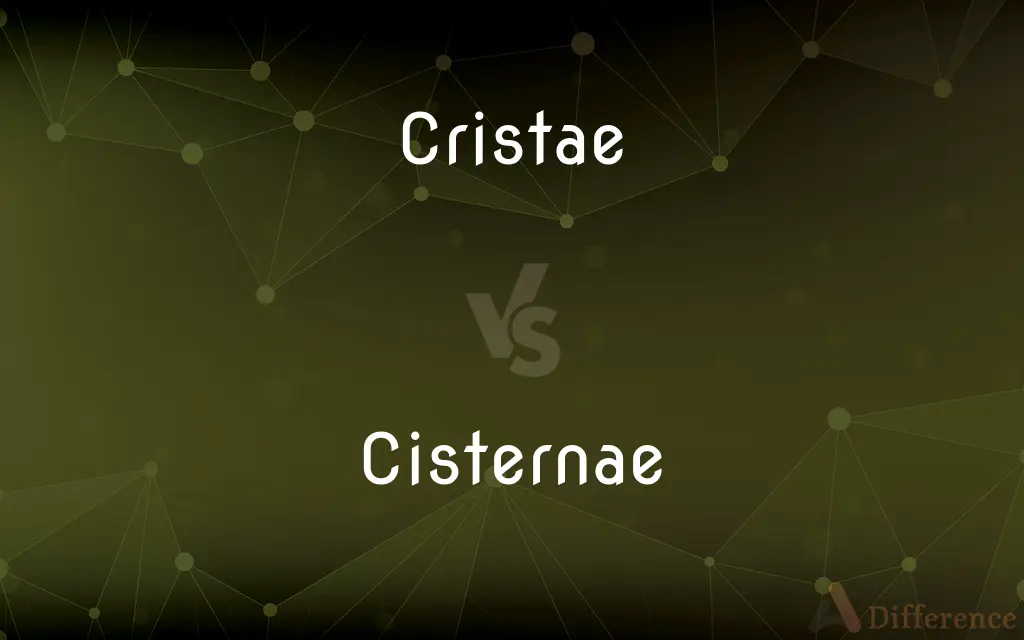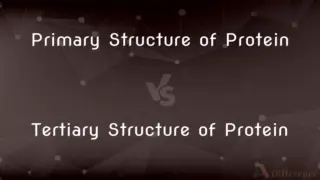Cristae vs. Cisternae — What's the Difference?
By Tayyaba Rehman & Fiza Rafique — Published on February 24, 2024
Cristae are the inner membrane structures of mitochondria that increase surface area for ATP production. Cisternae are flattened, stacked membrane pouches found within the Golgi apparatus and endoplasmic reticulum, involved in protein and lipid formation.

Difference Between Cristae and Cisternae
Table of Contents
ADVERTISEMENT
Key Differences
Cristae are integral components of mitochondria, the cell's powerhouse, characterized by their folded structure which significantly increases the inner membrane's surface area. This architectural feature is crucial for the mitochondrial function of energy production, as it provides ample space for the enzymes and electron carriers involved in the electron transport chain and ATP synthesis. The unique shape of cristae optimizes the efficiency of oxidative phosphorylation, the process by which cells generate ATP.
On the other hand, cisternae are found within the Golgi apparatus and the endoplasmic reticulum (ER), playing a vital role in the synthesis, modification, and sorting of proteins and lipids. In the Golgi apparatus, cisternae are involved in the further modification and packaging of proteins and lipids, preparing them for transport to their intended destinations, including secretion outside the cell or delivery to various intracellular locations. The ER's cisternae are involved in protein synthesis (rough ER) and lipid synthesis (smooth ER), highlighting their essential role in cellular metabolism and homeostasis.
The structural differences between cristae and cisternae reflect their distinct functional roles within the cell. While cristae are involved in energy transformation processes, cisternae are central to the cell's manufacturing and dispatching system. These structures exemplify the principle of form following function in cellular biology, with each structure's unique design tailored to its specific role in maintaining cellular life.
The study of cristae and cisternae not only provides insights into cellular energy production and protein processing but also underscores the complexity and efficiency of cellular organization. Disruptions in the structure or function of these components can lead to various diseases, highlighting their importance in cellular health and the broader context of human health.
Comparison Chart
Location
Mitochondria
Golgi apparatus and Endoplasmic Reticulum
ADVERTISEMENT
Structure
Folded inner membrane
Flattened, stacked membrane pouches
Function
Increase surface area for ATP production
Involved in protein and lipid processing
Role in Cell
Energy transformation
Protein synthesis, modification, and transport
Importance
Essential for cellular respiration
Crucial for cellular metabolism and homeostasis
Compare with Definitions
Cristae
Enhance mitochondrial surface area.
The numerous cristae within a mitochondrion facilitate ATP synthesis.
Cisternae
Sites of protein and lipid processing.
Rough ER cisternae are studded with ribosomes for protein synthesis.
Cristae
Reflects cellular energy demands.
Muscle cells contain mitochondria with extensive cristae for high energy needs.
Cisternae
Membrane-bound pouches in the ER and Golgi.
Cisternae in the Golgi apparatus modify proteins for export.
Cristae
Folded structures within mitochondria.
Cristae increase the efficiency of energy production in cells.
Cisternae
Involved in intracellular transport.
Cisternae facilitate the movement of substances within the cell.
Cristae
Integral to oxidative phosphorylation.
Enzymes located on cristae membranes drive the electron transport chain.
Cisternae
Structurally distinct in Golgi and ER.
Golgi cisternae are central to packaging and sorting cellular products.
Cristae
Adaptations for energy production.
Cristae architecture is optimized for maximal ATP output.
Cisternae
Indicative of cellular metabolic activity.
Secretory cells have well-developed cisternae for protein synthesis.
Cristae
(Biology) One of the inward projections or folds of the inner membrane of a mitochondrion.
Common Curiosities
Why are cristae important in mitochondria?
Cristae increase the inner membrane surface area, enhancing the capacity for ATP production, essential for cellular energy needs.
What is the main function of cisternae in the Golgi apparatus?
In the Golgi apparatus, cisternae modify, sort, and package proteins and lipids for transport to their destined locations.
Can the structure of cristae and cisternae change?
Yes, the structure of cristae and cisternae can change in response to cellular conditions, reflecting their adaptability to cellular needs.
How do cristae contribute to cellular respiration?
Cristae provide space for enzymes and proteins involved in the electron transport chain, facilitating efficient oxidative phosphorylation.
Do all cells contain cristae and cisternae?
All eukaryotic cells contain cisternae as part of the ER and Golgi apparatus, but only cells with mitochondria contain cristae.
How are proteins transported from cisternae?
Proteins are packaged into vesicles at the cisternae of the Golgi apparatus, which then transport the proteins to their destinations.
What role do cisternae play in protein synthesis?
Cisternae in the rough ER are sites where ribosomes attach to synthesize proteins, which are then processed and transported.
What happens if cristae or cisternae malfunction?
Malfunctioning cristae can lead to impaired energy production, while issues with cisternae can disrupt protein and lipid processing and transport, potentially causing various cellular dysfunctions and diseases.
What is the significance of the high surface area of cristae?
The high surface area allows for a greater number of ATP-producing enzymes and complexes, maximizing energy production.
How do cristae and cisternae differ in their formation?
Cristae are formed by the folding of the mitochondrial inner membrane, while cisternae are formed by the assembly of membrane-bound sacs in the ER and Golgi.
Share Your Discovery

Previous Comparison
Crucible vs. Evaporating DishAuthor Spotlight
Written by
Tayyaba RehmanTayyaba Rehman is a distinguished writer, currently serving as a primary contributor to askdifference.com. As a researcher in semantics and etymology, Tayyaba's passion for the complexity of languages and their distinctions has found a perfect home on the platform. Tayyaba delves into the intricacies of language, distinguishing between commonly confused words and phrases, thereby providing clarity for readers worldwide.
Co-written by
Fiza RafiqueFiza Rafique is a skilled content writer at AskDifference.com, where she meticulously refines and enhances written pieces. Drawing from her vast editorial expertise, Fiza ensures clarity, accuracy, and precision in every article. Passionate about language, she continually seeks to elevate the quality of content for readers worldwide.

















































